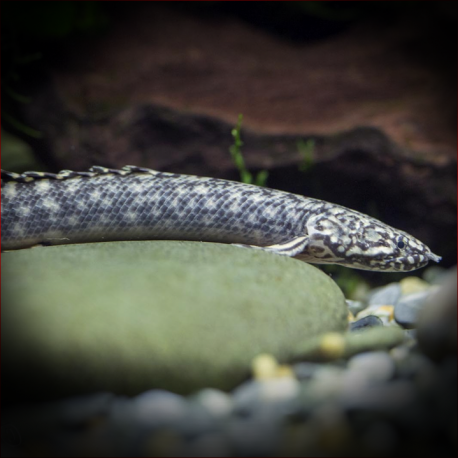More info
Datasheet
| Minimum Tank Size | 650 litres / 171.71 US gallons |
| Maximum Size | 60.0cm / 23.62inches |
| Temperature | 25°C / 77.00°F - 28°C / 82.40°F |
| Hardness | 5-25ºdH |
| pH | 6.0-8.0 |
General Description
An incredibly hardy, nocturnal species with very poor vision, Polypterus Ornatapinnis relies on its excellent sense of smell to locate food. This fish, part of the Polypteridae family, is one of the last surviving relatives of ancient species dating back over 200 million years. With intriguing adaptations like a divided swim bladder serving as an accessory breathing organ, this species can survive out of water for a period if kept moist. Young bichirs have external gills that vanish as they mature, showcasing their link between fish and amphibians. P. ornatapinnis, the largest of the upper-jawed tribe of polypterids, is visually striking and thrives in larger aquariums.
Aquarium Setup
For Polypterus Ornatapinnis, a tank size of at least 650 litres is recommended, emphasizing floor space over depth. The ideal setup includes a soft substrate, driftwood pieces, and smooth rocks to create hiding spots. While plants are not crucial, a secure, tight-fitting cover is essential as this species is known for its escapism. Water parameters should be maintained at a hardness of 5-25°dH, pH between 6.0-8.0, and a temperature range of 25-28°C (see table).
Behaviour
Notoriously incompatible with tankmates it can fit in its mouth, P. ornatapinnis is relatively peaceful otherwise. Suitable companions include other Polypterus species, Synodontis, Datnoides, Knife Fish, larger Ctenopoma species, characins, Rift lake cichlids, and African Butterfly Fish.
Feeding and Diet
Being carnivorous by nature, the Ornate Bichir prefers live or frozen foods like prawns, earthworms, mussels, and lancefish. While some specimens may accept pelleted varieties, most do not usually consume dried foods in aquarium settings.
Reproduction & Dimorphism
Reproduction of P. ornatapinnis in captivity is rare, with spawning likely induced by changes in water temperature and chemistry mimicking the rainy season. Breeding requires a large tank with soft, slightly acidic water and areas for egg scattering. Courtship involves male pursuit and fertilization of eggs before scattering them for incubation. The male's thicker anal fin distinguishes him from the female.
Habitat and Distribution
Found in various aquatic environments in countries like Cameroon, Democratic Republic of Congo, Burundi, Angola, and Tanzania, P. ornatapinnis inhabits rivers, ponds, marshes, and lakes, including Tanganyika.

